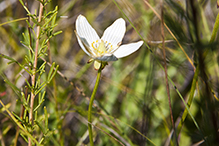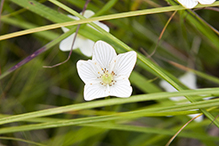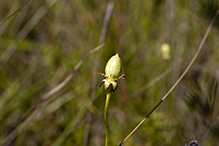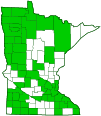fen grass of Parnassus
(Parnassia glauca)
Conservation • Wetland • Description • Habitat • Ecology • Use • Distribution • Taxonomy
Description |
||
Fen grass of Parnassus is a 8″ to 16″ tall, erect, perennial forb that rises from a short, thickened, underground stem (caudex) abd fibrous roots. Basal leaves are on long leaf stalks and form a rosette. They are stiff, leathery, hairless, egg-shaped to almost circular, 1⅛″ to 2″ long, and ⅝″ to 1¾″ wide. They are always longer than wide. The base is broadly rounded or slightly heart-shaped. The blade extends down the leaf stalk a short distance below the point of attachment. The margins are untoothed. A single, unbranched, hairless, 8″ to 16″ long flowering stalk (scape) rises from the rosette of basal leaves. There is usually a single leaf-like bract at or well below the middle of the stem. The bract is similar to the basal leaves only smaller. It is stalkless or on a short stalk, but does not clasp the stem. The inflorescence is a single flower held erect at the end of the stem. The flowers are ¾″ to 1½″ wide. Each flower has 5 green sepals and 5 white, ⅜″ to 11 ⁄16″ long petals with conspicuous, dark green veins. The 5 center veins of each petal are usually unbranched. There are 5 white stamens with brown anthers. There are also 5 white sterile stamens (staminodes) that are divided into 3 filaments for 3 ⁄5 or 4 ⁄5 of their length, each filament topped with an anther reduced to a gland. The staminodes are a little shorter than the stamens. The fruit is a 4-valved, egg-shaped, 5 ⁄16″ to ½″ long capsule with numerous seeds. |
||
Height |
||
8″ to 16″ |
||
Flower Color |
||
White with dark green veins |
||
Similar Species |
||
Marsh grass of Parnassus (Parnassia palustris) has a larger bract, as large as the basal leaves. The bract clasps the stem. The staminodes are green or yellow, and are divided near the tip into 9 to 23 filaments. |
||
Habitat |
||
Wet. Calcareous bogs, meadows, shores. |
||
Ecology |
||
Flowering |
||
August to October |
||
Pests and Diseases |
||
|
||
Use |
||
|
||
Distribution |
||||
|
Sources |
|||
| 4/16/2023 | ||||
Nativity |
||||
Native |
||||
Occurrence |
||||
|
||||
Taxonomy |
|||
| Kingdom | Plantae (Plants) | ||
| Division | Tracheophyta (Vascular Plants) | ||
| Subdivision | Spermatophytina (Seed Plants) | ||
| Class | Magnoliopsida (Dicots) | ||
Order |
Celastrales (staff-vines and allies) | ||
Family |
Celastraceae (staff-vine) | ||
| Subfamily | Parnassioideae | ||
| Tribe | Parnassieae | ||
Genus |
Parnassia (grass of Parnassus) | ||
Subordinate Taxa |
|||
|
|||
Synonyms |
|||
Parnassia americana |
|||
Common Names |
|||
American grass-of-Parnassus fen grass of Parnassus fen grass-of-Parnassus |
|||
Glossary
Bract
Modified leaf at the base of a flower stalk, flower cluster, or inflorescence.
Caudex
A short, thickened, woody, persistent enlargement of the stem, at or below ground level, used for water storage.
Clasping
Describing a leaf that wholly or partly surrounds the stem but does not fuse at the base.
Scape
An erect, leafless stalk growing from the rootstock and supporting a flower or a flower cluster.
Sepal
An outer floral leaf, usually green but sometimes colored, at the base of a flower.
Staminode
A modified stamen that produces no pollen. It often has no anther.
Visitor Photos |
|||||
Share your photo of this plant. |
|||||
| This button not working for you? Simply email us at info@MinnesotaSeasons.com. Attach one or more photos and, if you like, a caption. |
|||||
|
|||||
MinnesotaSeasons.com Photos |
|||||
Flower |
|||||
 |
 |
||||
 |
|||||
Fruit |
|||||
 |
|||||

Slideshows |
||

Visitor Videos |
|||
Share your video of this plant. |
|||
| This button not working for you? Simply email us at info@MinnesotaSeasons.com. Attach a video, a YouTube link, or a cloud storage link. |
|||
Other Videos |
|||

Visitor Sightings |
|||||
Report a sighting of this plant. |
|||||
| This button not working for you? Simply email us at info@MinnesotaSeasons.com. Be sure to include a location. |
|||||
|
|||||
MinnesotaSeasons.com Sightings |
|||||

|
Created: Last Updated: © MinnesotaSeasons.com. All rights reserved. |
